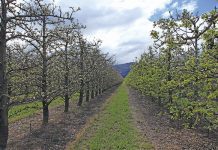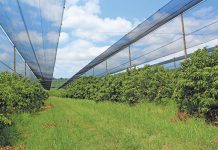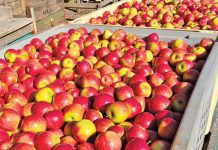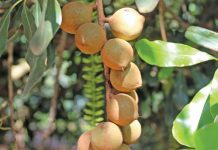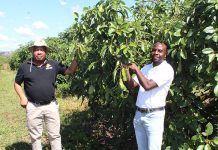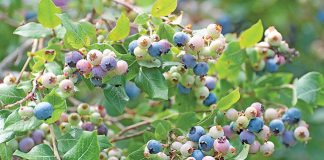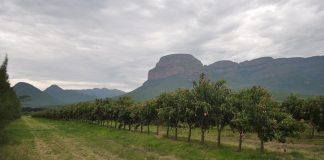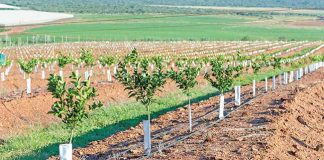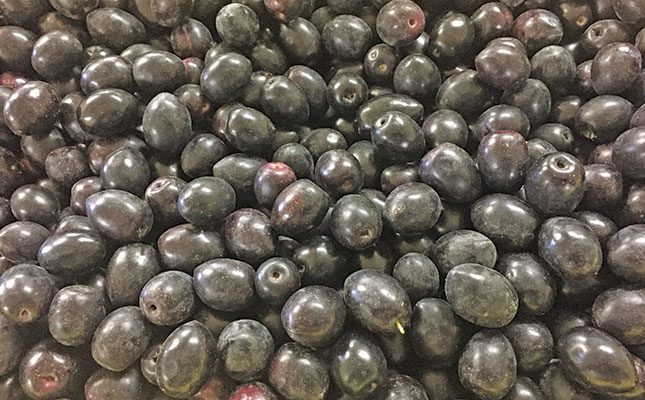
Photo: Magda du Toit
Most olive farming in South Africa takes place on small areas of farmland. In fact, according to Vittoria Jooste, CEO of the South African Olive Association (SA Olive), almost half of the 200 registered olive growers produce the fruit on fewer than 5ha.
Prospective olive and olive oil producers need to weigh up a number of factors before they can begin farming. Apart from the climate and soil type in their areas, they have to consider soil preparation, cultivar choice, harvesting, consumer preferences, and marketing, among others.
“Olive trees require a lot of care when it comes to food, water and pruning, but most of all, they require passion and love. If you focus on these, as well as investing in good people, you’ll be able to produce table olives and olive oil of predictable and sustainable quality,” says Dr Hannes Brummer, owner of Oudewerfskloof Olive Farm near Stilbaai, Western Cape.
Here, the Mediterranean-like conditions are ideal for olive production. According to the SA Olive website, another aspect for farmers to bear in mind is that olive trees depend upon vernalisation: they require sufficient winter chilling to enter their rest phase, which in turn will initiate their reproduction phase.
If vernalisation does not take place, the plant will remain vegetative; that is, it will not enter the reproduction phase. In the case of olives, if daytime temperatures in June and July exceed 21°C, the trees will not bear fruit.
At the other extreme, frost can seriously damage the trees, especially young trees and shoots, resulting in significant losses. Entire trees can die when exposed to temperatures of -7°C and below. On a positive note, olive trees are not as sensitive to wind damage as other fruit trees are.
Soil requirements
According to SA Olive’s production guidelines, olive trees require well-drained and well-aerated soils. Shallow soils make for challenging production, and trees in waterlogged soils are susceptible to asphyxia and root diseases. Soils should be prepared “to a depth of at least 80cm before planting”.
Heavy soils with a clay content of more than 35% are unsuitable for olive production, while stony soils with high gravel content are ideal. Very sandy soils with poor water-retention capacity will require intensive water-management practices.
A soil pH higher than 5,5, preferably closer to 6,5, is optimal, states SA Olive, adding that maintaining soil acidity is critical for facilitating the optimal uptake of plant nutrients.
Comprehensive soil preparation, which includes the deep ripping of the entire area, is needed prior to planting. A soil analysis should also be conducted, and lime and phosphates applied accordingly.
Cultivar selection
SA Olive states that the choice of cultivar will be determined by the following:
- Market
Before deciding whether to grow green or black olives, and whether to produce table olives or olive oil, farmers must look at market demand for these products, and the suitability of different cultivars for production. - Region
Farmers should consider the adaptability of a cultivar to their specific production region in terms of pest- and disease-resistance, tolerance of frost, soil type, and the availability of water for irrigation. The best cultivar is that which is well-suited to a specific farm’s climate and soil conditions. A combination of cultivars would help producers spread their risk. - Tree requirements
The needs of individual cultivars should be kept in mind, as should the fact that some cultivars require cross-pollination. - Harvest time
Producers should take into account the ripening periods and harvest seasons of the cultivars when choosing a variety. - Availability of planting material
SA Olive recommends that trees be ordered a year before planting, and only from nurseries registered with the association. The most widely grown olive cultivars in South Africa are Frantoio, Mission, Coratina and FS17, also known as Favolosa. Mission is suitable for both table olive and olive oil production, while Kalamata are used only for table olive production.
Production
When choosing trees to plant, farmers should look for those that have a healthy appearance, are about 18 months old and are at least 0,5m high. For successful establishment, the best time to plant is late winter or early spring.
It is best practice to space the trees 4m to 5m apart in the rows, with row spacing of between 6m and 7m. According to SA Olive, an alley width of 2m is sufficient to accommodate normal grove traffic. Under intensive management, trees can be spaced closer to each other and the height of the trees reduced.
It is often necessary to protect the stems of young trees against sunburn, herbicides and rodents. This can be done by encapsulating them with a carton-foil tube, for example.
The association also recommends the planting of sturdy bamboo or wooden stakes to support the trees during growth and protect them against wind damage. A tree’s central stem or leader should be tied loosely to the stake with twine.
When planting new trees, fertiliser must not be placed into the holes where it can come into direct contact with roots, as it may burn them.
Nutrient and water requirements
Like other fruit trees, olive trees require macronutrient elements such as nitrogen (N), potassium, phosphorus, calcium, magnesium and sulphur. Trace elements boron, zinc, iron, copper, manganese and molybdenum are required only in small quantities.
The correct management of N is critical to maintaining the balance between growth and cropping. To determine the correct application of this element, soil and leaf samples should be taken regularly.
When N is required, it should be applied regularly and in smaller doses, rather than a single large dose, in order to prevent excessive vegetative growth.
The grove’s water requirements will be determined by various factors, including the age and size of the trees; the season and growth stage; crop size; rainfall; temperature; relative humidity; evaporation rate; soil texture, structure and depth; and the type of irrigation system, among others.
According to Hennie Retief, co-owner of Olyfberg olive farm just outside Robertson in the Western Cape, effective irrigation, metered fertilisation and judicious pruning are critical aspects for determining the harvest each season.
“Some people think that because olives originated in drier areas [that is, in the Mediterranean region], they don’t need much water, but that’s not true. The correct amount of water at the right time is crucial. The more water you provide, the better your production will be,” he explains.
To encourage the growth of soil micro-organisms and promote soil health and effective water use, mulch can be used in the groves. It can be made by feeding the pruned branches, twigs and leaves into a chipper and spreading the chips around the trees above the root zone.
Sunlight requirements and pruning precision
Olive trees should receive at least six hours of sunlight every day. Pruning is normally
kept to a minimum during a grove’s first few years; only the branches that are growing too close to the soil surface or in the way of others need to be removed.
The approach to pruning will also depend on whether an extensive or intensive system is used. In an extensive system, for example, all upright growth in the centre of the tree is removed to improve canopy light interception, but care should be taken to avoid sunburn.
According to Brummer, pruning requires specialised attention and cannot be neglected.
“Radical and regular pruning will determine yield and quality,” he says.
Load-shedding during the reproductive phase and during harvesting and processing is a major challenge, says Jooste.
“Farmers incur additional costs for generators and fuel, to pay workers overtime, and as a result of fruit spoilage. “Some farmers are even considering installing solar-power systems, but these are tremendously expensive,” she explains.
Pests and diseases
In general, olive pests are kept in check by natural enemies, and the trees therefore lend themselves to the growing and marketing of organic products, explains SA Olive.
Growers should be careful not to disturb this balance through the indiscriminate use of pesticides, and should rather follow other practices to reduce pest infestation, such as correct pruning and minimising traffic dust.
If the trees must be sprayed, only chemicals registered for use on olives should be used. If farmers are unsure about which chemicals to use, they can refer to the most recent list, which is available from SA Olive.
Pest populations should be monitored at all times and, if possible, via a proper integrated pest management (IPM) system.
The Insectec website states that IPM is based on an ecosystem approach that focuses on long-term, sustainable solutions for the management of pests. These systems aim to reduce the use of non-selective chemicals and produce healthy crops with minimal impact on the health of both the environment and humans, it adds.
On its website, SA Olives lists the following main olive pests:
- The olive beetle (Agropistes olea) is normally yellow with black stripes, and resembles a ladybird in shape and size.
- When disturbed, it has a habit of jumping instead of flying. The adults attack the fruit and leave scars. They lay their yellow eggs on the undersides of the leaves, and sometimes cover them with excrement.
- Upon hatching, the bright-yellow larvae eat and tunnel into the leaves of young trees, hindering new growth.
- The lace bug (Plerochila australis). Also known as the olive tingid, this pest sucks the sap from the leaves, causing tiny yellow dots to form on the leaves, which later become completely chlorotic and die.
- The olive fruit fly (Bactrocera oleae). This pest penetrates the fruit and lays its eggs inside, where they hatch. The larvae burrow through the flesh of the fruit, destroying it as they go.
- The olive psyllid (Euphyllura olivina). A small sucking insect, this plant louse is related to the aphid. It lays its eggs on new growth, and the nymphs secrete honeydew, as well as a white waxy substance that resembles cotton wool.
- Soft olive scale. There are two species of soft olive scale: black scale (Saissetia oleae) and brown soft scale (Coccus hesperidum). The eggs hatch into tiny yellow crawlers that cover the surface of the tree. They can be spread to neighbouring trees by people, birds and wind.
- Armoured olive scale. This includes two species, namely oleander scale (Aspidiotus nerii) and red scale (Aonidiella aurantii). The species settle down permanently after a day or two in the crawler stage, moult, and then begin to form their characteristic covers. Scale occurs on the branches, leaves and fruit. Where the scales feed on the fruit, one might find deformation, delayed ripening and changes in colour.
According to the SA Olive website, the main fungal diseases of olive trees are:
- Anthracnose, caused by the fungus Colletotrichum gloeosporioides, which causes fruit spoilage and canker on shoots.
- Peacock spot, caused by the fungal pathogen Spilocaea oleaginea, which causes sooty spots and the yellowing of leaves, later resulting in leaf drop and the death of shoots.
- Various soilborne diseases, such as Phytophthora root rot and Verticillium wilt, can cause damage to the roots, resulting in the death of trees.
- Weeds compete with the trees for available moisture, nutrients and oxygen in the soil. Such competition can be reduced by regular mowing, or by spraying with herbicides.
In South Africa, only glyphosate and fluazifop-P butyl, both used post-emergence, are currently registered for use on olives, according to SA Olive.
Harvesting
Olive harvesting is highly labour-intensive. Table olives are picked by hand, while oil olives may be stripped off the trees onto nets placed on the ground.
The harvest date depends on the cultivar and the purpose for which the fruit is intended, and normally stretches from February to July in the Western Cape.
Fruit intended for green processing is picked once it has turned from bright green to yellow-green, and is showing a light-pink or purple blush.
Only the fruit of the required size should be harvested, while the rest must be left for later picking. Fruit intended for processing, such as ripe black table olives, should be picked after it has turned completely black, but before its has softened and become overripe.
Oil olives should be harvested when most of the fruit on the tree is ripe enough. The entire tree should be harvested, according to the advice laid out in SA Olive’s production guidelines on its website. As fruit colours and ripens, the oil content rises, but if the harvest is delayed for too long, the quality of the oil will be negatively affected.
Email Vittoria Jooste at [email protected], Hennie Retief at [email protected], or Dr Hannes Brummer at [email protected].


